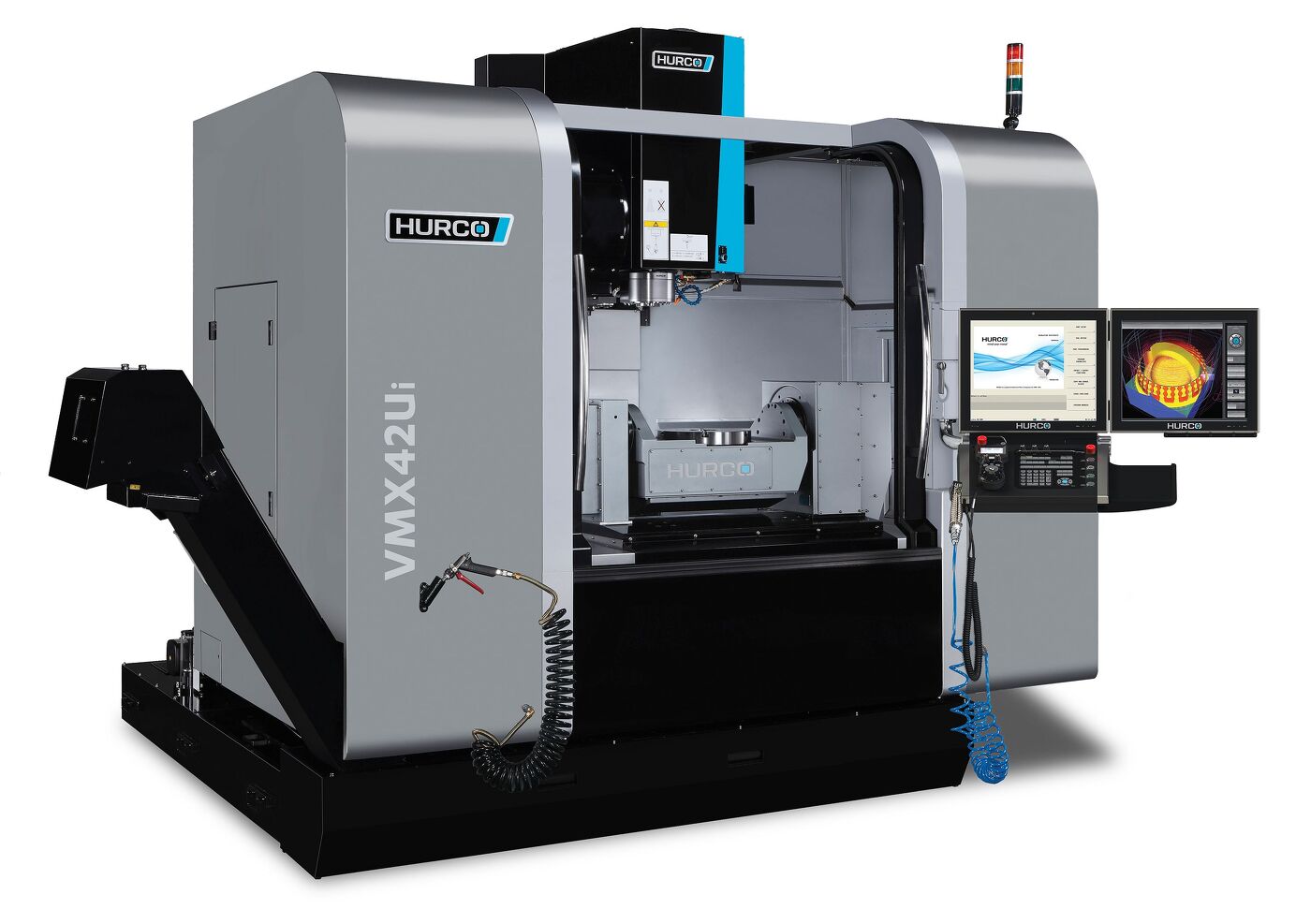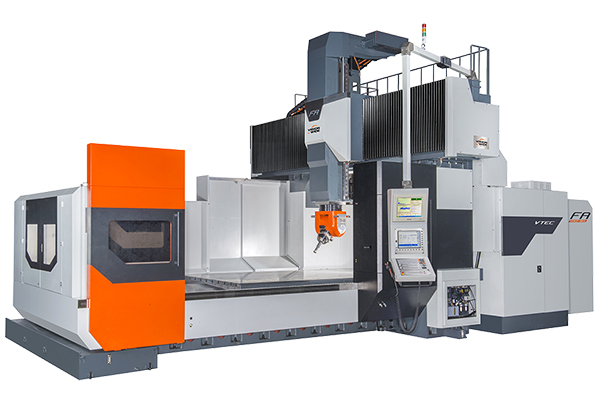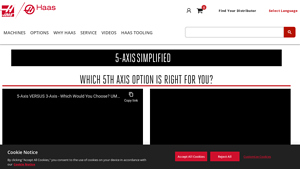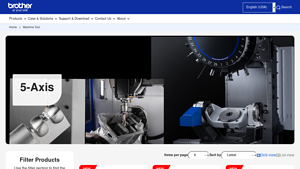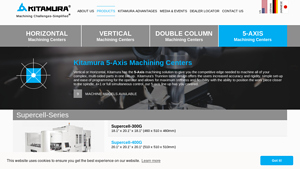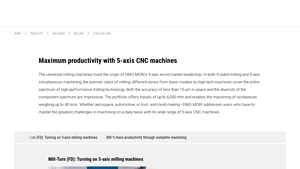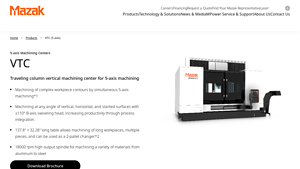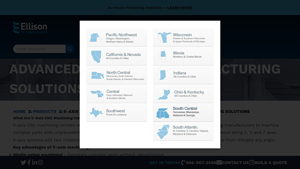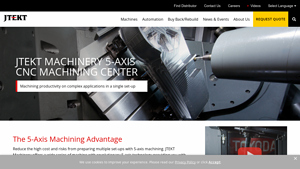5 Axis Cnc Machining Center Guide: Type, Cost, Top List…
Introduction: Navigating the Global Market for 5 axis cnc machining center
In today’s competitive manufacturing landscape, sourcing a 5-axis CNC machining center presents a unique challenge for international B2B buyers. As industries evolve and the demand for precision and efficiency skyrockets, the ability to effectively navigate the complexities of the global market becomes crucial. This comprehensive guide delves into the various types of 5-axis CNC machining centers, their diverse applications across sectors such as aerospace, medical, and automotive, and essential considerations for supplier vetting and cost analysis.
By addressing critical factors like technology advancements, operational efficiencies, and ROI potential, this guide empowers decision-makers from Africa, South America, the Middle East, and Europe—including key markets like Saudi Arabia and Brazil—to make informed purchasing decisions. It equips buyers with the insights needed to evaluate not only the machines themselves but also the long-term benefits they offer in terms of productivity and competitiveness.
With an authoritative and solution-oriented approach, this resource aims to simplify the process of integrating 5-axis CNC machining into existing workflows, ensuring that your business remains at the forefront of innovation and efficiency in an ever-changing global market. Whether you are looking to enhance your manufacturing capabilities or streamline operations, this guide is your go-to resource for navigating the intricacies of acquiring a 5-axis CNC machining center.
Understanding 5 axis cnc machining center Types and Variations
| Type Name | Key Distinguishing Features | Primary B2B Applications | Brief Pros & Cons for Buyers |
|---|---|---|---|
| Trunnion Table Machines | Utilizes a rotating table to enable machining from multiple angles. | Aerospace components, automotive parts | Pros: High precision, versatile; Cons: Higher initial cost, requires skilled operators. |
| Tilt-Rotary Machines | Combines tilting and rotating capabilities for complex geometries. | Medical implants, complex molds | Pros: Excellent for intricate designs; Cons: More complex setup, potential for longer learning curve. |
| Hybrid Machines | Integrates additive manufacturing with traditional CNC capabilities. | Prototyping, aerospace, and medical sectors | Pros: Reduces waste, allows for innovative designs; Cons: Higher maintenance, specialized training needed. |
| Vertical 5-Axis Mills | Features a vertical spindle with 5-axis capabilities for compact setups. | General manufacturing, mold making | Pros: Space-efficient, good for small parts; Cons: Limited to lighter materials, may not handle larger components well. |
| Horizontal 5-Axis Mills | Offers horizontal spindle orientation, ideal for heavy and large parts. | Heavy machinery, automotive components | Pros: Better chip removal, suitable for larger workpieces; Cons: Requires more floor space, often more expensive. |
What Are Trunnion Table Machines and Their Suitability for B2B Buyers?
Trunnion table machines are characterized by their rotating worktables, allowing for multi-angle machining without the need for repositioning the part. This type is particularly suitable for industries such as aerospace and automotive, where precision and complex geometries are paramount. When considering a trunnion machine, buyers should evaluate the machine’s accuracy, the skill level of their operators, and the potential return on investment, given the higher initial costs.
How Do Tilt-Rotary Machines Enhance Complex Part Manufacturing?
Tilt-rotary machines provide both tilting and rotating functionalities, making them ideal for creating intricate designs, especially in medical and mold manufacturing. These machines excel in producing complex geometries that traditional machines struggle with. Buyers must consider the learning curve associated with setup and operation, as well as the machine’s capability to handle specific materials and designs.
What Advantages Do Hybrid Machines Offer in Modern Manufacturing?
Hybrid machines merge additive and subtractive manufacturing processes, making them highly versatile for prototyping and production in aerospace and medical sectors. They allow for innovative designs while minimizing material waste. However, potential buyers should be prepared for higher maintenance costs and the need for specialized training to operate these advanced machines effectively.
Why Choose Vertical 5-Axis Mills for General Manufacturing?
Vertical 5-axis mills are compact and efficient, making them an excellent choice for general manufacturing and mold making. Their vertical spindle design is particularly suited for smaller parts, allowing for high precision in machining. Buyers should weigh the benefits of space efficiency against the limitations in handling larger components or heavier materials.
What Are the Key Features of Horizontal 5-Axis Mills for Heavy Parts?
Horizontal 5-axis mills are designed for larger and heavier workpieces, providing superior chip removal and improved machining performance. They are commonly used in heavy machinery and automotive applications. Buyers should consider the trade-offs between floor space requirements and the machine’s ability to handle large-scale operations, as well as the overall cost of investment.
Key Industrial Applications of 5 axis cnc machining center
| Industry/Sector | Specific Application of 5 axis cnc machining center | Value/Benefit for the Business | Key Sourcing Considerations for this Application |
|---|---|---|---|
| Aerospace | Manufacturing turbine blades | High precision reduces material waste and enhances performance | Compliance with stringent aerospace standards and certifications |
| Medical | Production of orthopedic implants | Increased accuracy improves patient outcomes and reduces costs | Need for biocompatible materials and stringent quality control |
| Automotive | Fabrication of complex engine components | Streamlined production lowers costs and improves efficiency | Supplier reliability and capability to handle high-volume orders |
| Oil and Gas | Machining of valve bodies and fittings | Enhanced durability and performance in harsh environments | Understanding of industry-specific materials and tolerances |
| Defense | Production of intricate weapon components | Precision manufacturing meets strict defense specifications | Proven track record in defense contracts and security clearances |
How is 5-Axis CNC Machining Center Used in Aerospace Manufacturing?
In the aerospace sector, 5-axis CNC machining centers are pivotal for producing turbine blades, which require intricate geometries and high precision. This technology allows manufacturers to machine complex shapes in a single setup, significantly reducing cycle times and material waste. Buyers in this field must ensure that their suppliers comply with stringent aerospace standards and possess the necessary certifications to guarantee the quality and safety of the parts produced.
What are the Applications in the Medical Industry with 5-Axis CNC Machining?
The medical industry benefits greatly from 5-axis CNC machining centers, particularly in the production of orthopedic implants. These implants require exceptional accuracy and the ability to create complex shapes that fit the human anatomy. By utilizing 5-axis machining, manufacturers can produce high-quality components that enhance patient outcomes while minimizing production costs. International buyers should focus on suppliers that use biocompatible materials and adhere to rigorous quality control processes to meet regulatory standards.
How Does 5-Axis CNC Machining Center Improve Automotive Component Fabrication?
In automotive manufacturing, 5-axis CNC machining centers are essential for fabricating complex engine components that demand high precision and efficiency. This technology streamlines production processes by allowing multiple features to be machined in a single setup, reducing the need for manual repositioning. For buyers in this sector, sourcing from suppliers who can handle high-volume orders and demonstrate reliability is crucial to maintaining production schedules and quality standards.
What are the Key Benefits of 5-Axis CNC Machining in the Oil and Gas Sector?
The oil and gas industry utilizes 5-axis CNC machining centers for the production of valve bodies and fittings, which must withstand extreme conditions. The ability to create durable and precise components enhances the performance of machinery in harsh environments. Buyers should consider suppliers with a deep understanding of industry-specific materials and tolerances, as well as a proven ability to deliver high-quality components that meet operational demands.
How is 5-Axis CNC Machining Used in Defense Manufacturing?
In defense manufacturing, 5-axis CNC machining centers are employed to produce intricate components for weapons systems, where precision is paramount. The technology allows for complex geometries to be machined efficiently, adhering to strict defense specifications. Buyers looking to source from this sector should prioritize suppliers with a proven track record in defense contracts and the necessary security clearances to ensure compliance with sensitive regulations.
3 Common User Pain Points for ‘5 axis cnc machining center’ & Their Solutions
Scenario 1: Challenges with Complex Part Designs
The Problem: Many B2B buyers encounter significant difficulties when tasked with machining complex parts that have intricate geometries. Industries such as aerospace, medical, and automotive demand components with complex features that traditional 3-axis machines struggle to produce efficiently. These complexities often lead to extended setup times, increased labor costs, and a higher likelihood of errors during the machining process. Buyers find themselves frustrated with the limitations of their existing equipment and the constant need for manual repositioning, which can significantly delay production schedules and compromise precision.
The Solution: To effectively address these challenges, buyers should invest in a high-quality 5-axis CNC machining center that allows simultaneous movement across five axes. When sourcing these machines, it is crucial to evaluate their capabilities in handling multi-sided machining. Buyers should look for features such as advanced control systems, high-speed spindles, and robust tooling options that enhance flexibility and precision. Additionally, consider investing in training programs for operators to maximize the machine’s capabilities and minimize human error. Utilizing simulation software during the design phase can also aid in visualizing complex machining operations, ensuring that setups are optimized before physical production begins.
Scenario 2: High Setup Costs and Inefficiencies
The Problem: Another common pain point for buyers is the high cost associated with machine setups and the inefficiencies they create. Traditional machining often requires multiple setups, which not only increases labor costs but also leads to longer lead times and potential discrepancies between operations. These inefficiencies can erode profit margins, especially in competitive markets where speed and precision are paramount. Buyers may feel overwhelmed by the financial implications of frequent setups and the challenge of justifying these costs to stakeholders.
The Solution: Investing in a 5-axis CNC machining center can significantly reduce setup times and associated costs. By enabling the machining of complex parts in a single setup, these machines minimize the need for repositioning, thus enhancing operational efficiency. Buyers should conduct a thorough cost-benefit analysis to assess the potential return on investment (ROI) from acquiring a 5-axis system. Additionally, they should engage with suppliers who offer comprehensive training and support, ensuring that their teams can operate the machines efficiently from day one. Regularly reviewing production workflows to identify bottlenecks can also help in fine-tuning processes and maximizing the benefits of the new machinery.
Scenario 3: Skills Gap and Workforce Challenges
The Problem: A pervasive issue in the manufacturing sector is the skills gap, particularly concerning advanced machining technologies like 5-axis CNC. Many B2B buyers struggle to find qualified personnel who are adept at operating and programming 5-axis machines. This shortage can lead to delays in production, increased reliance on external contractors, and ultimately, a lack of control over quality and timelines. Companies may feel the pressure of meeting customer demands while grappling with the challenges of a workforce that lacks the necessary skills.
The Solution: To tackle the skills gap effectively, buyers should consider partnering with educational institutions or industry training programs that focus on CNC machining. Investing in ongoing training and certification programs for existing staff can elevate their skill sets and enhance job satisfaction, thereby reducing turnover. Moreover, implementing mentorship programs within the company can facilitate knowledge transfer from experienced machinists to newer employees. Buyers can also explore user-friendly software solutions that simplify programming for 5-axis operations, making it easier for less experienced operators to produce high-quality work. By fostering a culture of continuous learning and adapting to technological advancements, companies can build a competent workforce ready to leverage the capabilities of 5-axis CNC machining.
Strategic Material Selection Guide for 5 axis cnc machining center
What are the Key Properties of Aluminum for 5-Axis CNC Machining?
Aluminum is a widely used material in 5-axis CNC machining due to its excellent machinability, lightweight nature, and corrosion resistance. Key properties include a low density, good thermal conductivity, and a melting point of around 660°C. These characteristics make aluminum suitable for applications requiring precision and lightweight components, such as aerospace and automotive parts.
Pros and Cons of Using Aluminum
The primary advantages of aluminum include its durability, ease of machining, and cost-effectiveness. It is also highly recyclable, which appeals to environmentally conscious buyers. However, aluminum can be less suitable for high-temperature applications due to its lower melting point compared to other metals. Additionally, while it is resistant to corrosion, it may not withstand harsh chemical environments as effectively as some alternatives.
Impact on Application
Aluminum’s compatibility with a variety of media makes it a versatile choice for many applications. However, international buyers should consider the specific grades of aluminum, such as 6061 or 7075, which have different mechanical properties and corrosion resistance levels, impacting their suitability for various environments.
How Does Steel Perform in 5-Axis CNC Machining?
Steel, particularly stainless steel, is another common material used in 5-axis CNC machining. It boasts high tensile strength, excellent durability, and good resistance to wear and corrosion. Stainless steel, for example, has a melting point around 1400-1450°C, making it suitable for high-temperature applications.
Pros and Cons of Using Steel
The key advantages of steel include its strength and ability to withstand high stress and temperature variations. It is ideal for applications in the oil and gas industry, where durability is crucial. However, steel can be more challenging to machine than aluminum, leading to higher manufacturing costs and complexity. Additionally, the weight of steel can be a disadvantage in applications where lightweight components are preferred.
Impact on Application
Steel’s compatibility with various media, including corrosive substances, makes it a preferred choice in demanding environments. International buyers must be aware of compliance with standards such as ASTM A240 for stainless steel, which ensures quality and performance across different markets.
What are the Advantages of Using Titanium in 5-Axis CNC Machining?
Titanium is renowned for its exceptional strength-to-weight ratio and corrosion resistance, making it suitable for high-performance applications in aerospace and medical industries. Key properties include a melting point of approximately 1668°C and excellent biocompatibility.
Pros and Cons of Using Titanium
The primary advantage of titanium is its ability to perform well under extreme conditions, including high temperatures and corrosive environments. However, it is significantly more expensive than aluminum and steel, which can impact project budgets. Additionally, titanium is more difficult to machine, requiring specialized tools and techniques, which can increase manufacturing complexity.
Impact on Application
Titanium’s compatibility with various media, particularly in medical applications, makes it an excellent choice for implants and surgical instruments. Buyers from regions with stringent quality standards, such as Europe, should ensure compliance with ISO 5832 for medical-grade titanium.
What Role Does Plastic Play in 5-Axis CNC Machining?
Plastics, particularly engineering-grade materials like PEEK and nylon, are increasingly utilized in 5-axis CNC machining. These materials offer excellent chemical resistance, lightweight properties, and good thermal stability, with melting points varying widely depending on the specific type of plastic.
Pros and Cons of Using Plastic
The advantages of using plastics include lower costs and ease of machining compared to metals. They are also resistant to corrosion and can be tailored for specific applications. However, plastics may not be suitable for high-stress applications due to lower tensile strength and durability compared to metals.
Impact on Application
Plastics are ideal for applications in industries such as consumer goods and electronics, where weight and corrosion resistance are critical. International buyers should consider compliance with material safety standards, such as RoHS in Europe, to ensure the suitability of plastics for their intended applications.
Summary Table of Material Selection for 5-Axis CNC Machining
| Material | Typical Use Case for 5 axis cnc machining center | Key Advantage | Key Disadvantage/Limitation | Relative Cost (Low/Med/High) |
|---|---|---|---|---|
| Aluminum | Aerospace components, automotive parts | Lightweight and easy to machine | Lower temperature resistance | Medium |
| Steel | Oil and gas equipment, structural components | High strength and durability | More challenging to machine | Medium to High |
| Titanium | Aerospace and medical implants | Exceptional strength-to-weight ratio | High cost and machining complexity | High |
| Plastic | Consumer goods, electronics | Cost-effective and corrosion-resistant | Lower strength and durability | Low |
In-depth Look: Manufacturing Processes and Quality Assurance for 5 axis cnc machining center
What Are the Main Stages of Manufacturing for a 5-Axis CNC Machining Center?
The manufacturing process of a 5-axis CNC machining center involves several critical stages, each contributing to the machine’s precision and reliability. Understanding these stages is vital for B2B buyers, especially those looking to source high-quality machinery.
How Is Material Prepared for 5-Axis CNC Machining?
The first stage is material preparation, which involves selecting the appropriate raw materials, typically metals like aluminum, titanium, or stainless steel. The material must be cut to size and often involves preliminary machining to ensure it meets the specifications required for the final product. Advanced techniques such as laser cutting or waterjet cutting can be utilized to ensure accuracy. Additionally, suppliers often conduct an initial inspection to check for any defects in the material, ensuring that only the best quality stock is used.
What Forming Techniques Are Used in 5-Axis CNC Machining?
Once the material is prepared, it undergoes the forming stage, where the machining process begins. In 5-axis machining, the tool and workpiece can move simultaneously along five different axes. This allows for complex geometries and shapes to be produced efficiently. Key techniques include milling, drilling, and grinding, which are executed using specialized cutting tools designed for various materials and shapes. This capability significantly reduces the need for multiple setups and manual repositioning, thus enhancing efficiency and precision.
How Is the Assembly Process Managed for 5-Axis CNC Machining Centers?
After the forming stage, assembly is crucial, especially if the machining center consists of multiple components. The assembly process involves fitting together various parts such as the spindle, tool holders, and control systems. Quality control at this stage is vital, as any misalignment or improper fitting can affect the machine’s performance. Manufacturers typically employ automated assembly lines or skilled technicians to ensure precise assembly, followed by thorough testing of each component before final assembly.
What Finishing Techniques Are Applied in 5-Axis CNC Machining?
The final stage is finishing, where additional processes such as polishing, coating, or anodizing may be applied to enhance the machine’s durability and aesthetics. Finishing processes not only improve the surface quality but also provide protection against corrosion and wear. Inspection during this phase is crucial, as it ensures that the final product meets all aesthetic and functional specifications required by the buyer.
What International Standards and Quality Assurance Practices Are Relevant?
Quality assurance is a critical aspect of the manufacturing process for 5-axis CNC machining centers. Various international standards ensure that these machines meet specific safety and performance criteria.
Which International Quality Standards Should B2B Buyers Consider?
The ISO 9001 standard is fundamental for quality management systems across industries. This certification ensures that manufacturers adhere to consistent quality control processes throughout their operations. Additionally, industry-specific standards such as CE (Conformité Européenne) for European markets and API (American Petroleum Institute) standards for oil and gas applications are also significant. These certifications indicate compliance with essential safety and performance requirements, providing B2B buyers with confidence in the quality of their purchases.
What Are the Key Quality Control Checkpoints in the Manufacturing Process?
Quality control (QC) is integrated at various checkpoints throughout the manufacturing process of 5-axis CNC machining centers. Understanding these checkpoints can help buyers assess the reliability of their suppliers.
How Do Incoming Quality Control (IQC) and In-Process Quality Control (IPQC) Work?
Incoming Quality Control (IQC) involves inspecting raw materials upon arrival to ensure they meet predefined specifications. This step is crucial to prevent defects from the outset. In-Process Quality Control (IPQC) occurs during the machining process, where operators monitor machining operations to detect any deviations from quality standards. Techniques such as Statistical Process Control (SPC) may be employed to analyze data and ensure processes are within specified limits.
What Is Final Quality Control (FQC) and Its Importance?
Final Quality Control (FQC) is the last checkpoint before a product is shipped. It includes comprehensive testing and inspections to verify that the machine meets all specifications and standards. Common testing methods include dimensional inspections, functional tests, and performance evaluations. This stage is vital for ensuring that the final product will perform reliably in the field.
How Can B2B Buyers Verify Supplier Quality Control Practices?
For international B2B buyers, verifying the quality control practices of suppliers is essential to ensure a reliable purchase.
What Are the Best Practices for Conducting Supplier Audits?
Conducting supplier audits is one of the most effective ways to assess the quality control processes in place. Buyers should request access to quality control documentation, including inspection reports, certifications, and process flows. On-site audits allow buyers to observe the manufacturing environment and practices firsthand, ensuring that suppliers adhere to international standards.
How Can Third-Party Inspections Enhance Buyer Confidence?
Engaging third-party inspection services provides an additional layer of verification. Independent inspectors can evaluate the manufacturing process, conduct tests, and ensure compliance with relevant standards. This approach is particularly beneficial for buyers from regions such as Africa, South America, and the Middle East, where supplier reliability may vary.
What Are the Quality Control and Certification Nuances for International Buyers?
Understanding the nuances of quality control and certifications is crucial for international B2B buyers. Different regions may have varying expectations regarding compliance and standards.
How Do Regional Differences Impact Quality Assurance?
For buyers in regions like Europe, compliance with CE marking is essential for market access. In contrast, buyers in the Middle East may prioritize compliance with local standards and regulations. It is crucial for buyers to communicate their specific requirements and understand the certifications that suppliers hold, ensuring that the products meet regional regulations.
By being aware of these manufacturing processes and quality assurance practices, B2B buyers can make informed decisions when sourcing 5-axis CNC machining centers, ensuring they partner with reliable suppliers who meet international quality standards.
Practical Sourcing Guide: A Step-by-Step Checklist for ‘5 axis cnc machining center’
To facilitate a successful procurement process for a 5-axis CNC machining center, this guide outlines essential steps for B2B buyers. By following this checklist, you can ensure that your investment meets your operational needs while maximizing efficiency and productivity.
Step 1: Define Your Technical Specifications
Establishing clear technical specifications is vital for selecting the right 5-axis CNC machining center. Determine the materials you will be machining, the types of components you will produce, and the required precision levels. This foundational step helps you narrow down options that can effectively handle your specific workload.
- Considerations:
- Size and weight of the components.
- Tolerance levels and surface finish requirements.
Step 2: Assess Your Production Needs
Understanding your production volume and cycle times will guide your choice of machine. High-volume operations may benefit from machines with faster cycle times and higher spindle speeds, while lower-volume jobs might allow for more flexible options.
- Questions to Ask:
- What is the expected daily output?
- Are there specific job types that require specialized features?
Step 3: Evaluate Potential Suppliers
Before committing to a purchase, thoroughly vet potential suppliers. Request company profiles, case studies, and references from similar industries. Look for suppliers with a proven track record in providing reliable support and service.
- Key Actions:
- Check online reviews and testimonials.
- Ask for a list of clients in your industry for insights on their experiences.
Step 4: Verify Supplier Certifications
Certifications can be indicative of a supplier’s commitment to quality and standards. Ensure that the suppliers you are considering have relevant certifications such as ISO 9001, which reflects their adherence to quality management systems.
- Why It Matters:
- Certifications provide assurance of consistent quality and reliability.
- They can also facilitate smoother import/export processes, especially in international transactions.
Step 5: Request Demonstrations or Trials
Whenever possible, request a demonstration of the CNC machining center you are considering. Observing the machine in action can provide insights into its performance, ease of use, and capabilities.
- Considerations:
- Ask for demonstrations on parts similar to your production needs.
- Check the machine’s software interface for usability.
Step 6: Analyze Total Cost of Ownership
Beyond the initial purchase price, consider the total cost of ownership, which includes maintenance, tooling, and operational costs. A machine with a higher upfront cost may be more economical in the long run if it offers better energy efficiency or lower maintenance needs.
- Components to Evaluate:
- Maintenance schedules and costs.
- Energy consumption and tooling expenses.
Step 7: Negotiate Terms and Conditions
Once you’ve identified a suitable supplier, negotiate the terms of the purchase. This includes warranty periods, service agreements, and payment terms. A well-structured agreement can safeguard your investment and ensure ongoing support.
- Important Aspects:
- Warranty coverage specifics and service response times.
- Terms for potential upgrades or additional training.
By following this practical sourcing guide, you can make informed decisions that align with your business objectives and operational requirements, ensuring a successful investment in a 5-axis CNC machining center.
Comprehensive Cost and Pricing Analysis for 5 axis cnc machining center Sourcing
What Are the Key Cost Components in Sourcing a 5-Axis CNC Machining Center?
When evaluating the costs associated with sourcing a 5-axis CNC machining center, it is essential to consider several key components. The primary cost elements include materials, labor, manufacturing overhead, tooling, quality control (QC), logistics, and profit margins.
-
Materials: The type and quality of materials used in the construction of the CNC machine significantly impact the overall cost. High-quality steel and aluminum components are often used, which can increase initial expenses but lead to greater durability and performance.
-
Labor: Labor costs encompass not only the wages of assembly workers but also the expertise required for setup and maintenance. Skilled labor is often more expensive, especially in regions where such expertise is scarce.
-
Manufacturing Overhead: This includes indirect costs such as utilities, rent, and equipment depreciation. Efficient manufacturing processes can reduce overhead, allowing suppliers to offer more competitive pricing.
-
Tooling: Specialized tooling required for 5-axis machining, such as advanced cutting tools and fixtures, adds to the overall cost. The choice of tooling can also affect the machine’s performance and the quality of the finished product.
-
Quality Control: Rigorous QC processes ensure that machines meet industry standards and client specifications. Implementing comprehensive QC can elevate costs but is crucial for maintaining high-quality output.
-
Logistics: Transportation and shipping costs can vary widely based on geographic location and the chosen shipping method. Factors such as Incoterms can also influence the total logistics expense.
-
Margin: Suppliers will incorporate a profit margin into their pricing, which can vary based on market conditions and competition.
How Do Price Influencers Impact the Cost of 5-Axis CNC Machining Centers?
Several factors can influence the pricing of 5-axis CNC machining centers, including volume, specifications, materials, quality certifications, supplier reputation, and Incoterms.
-
Volume/MOQ: Higher order volumes typically lead to lower per-unit costs due to economies of scale. Buyers should negotiate minimum order quantities (MOQs) that align with their production needs.
-
Specifications/Customization: Custom features and advanced specifications can significantly increase costs. Buyers must balance their specific needs with budget constraints, considering whether standard models can suffice.
-
Materials: The choice of materials affects both performance and price. Opting for standard-grade materials can help reduce costs, but this may compromise the machine’s capabilities.
-
Quality/Certifications: Machines that come with recognized quality certifications often carry a premium price. However, investing in certified equipment can lead to lower total ownership costs due to reduced downtime and maintenance.
-
Supplier Factors: The reputation and experience of the supplier can impact pricing. Established suppliers may charge more but often provide better support and reliability.
-
Incoterms: Understanding Incoterms is vital for international buyers. They define the responsibilities of buyers and sellers, impacting shipping costs and risk management.
What Are Effective Buyer Tips for Sourcing 5-Axis CNC Machining Centers?
International B2B buyers, particularly from regions like Africa, South America, the Middle East, and Europe, should adopt strategic approaches to optimize their sourcing process.
-
Negotiation: Engaging in active negotiation can lead to better pricing. Buyers should be prepared to discuss volume discounts and payment terms to secure favorable deals.
-
Cost-Efficiency: Evaluate the total cost of ownership (TCO), which includes purchase price, maintenance, and operational costs over the machine’s lifespan. A lower initial cost may not always translate to savings in the long run.
-
Pricing Nuances: Be aware of price fluctuations influenced by regional economic conditions, tariffs, and trade agreements. Staying informed about market trends can help buyers make timely purchasing decisions.
-
Supplier Relationships: Building strong relationships with suppliers can lead to better service, support, and potential discounts on future purchases.
Disclaimer for Indicative Prices
Prices for 5-axis CNC machining centers can vary widely based on specifications, supplier, and market conditions. This analysis provides a framework for understanding cost structures and pricing influencers but should not be interpreted as definitive pricing. Buyers are encouraged to conduct thorough market research and obtain multiple quotes to ensure competitive pricing for their specific needs.
Alternatives Analysis: Comparing 5 axis cnc machining center With Other Solutions
Introduction: Understanding Alternatives in CNC Machining
In the competitive landscape of manufacturing, choosing the right machining technology is critical for efficiency and profitability. While 5-axis CNC machining centers are lauded for their ability to produce complex geometries with precision, it’s essential to consider alternative solutions that may better suit specific business needs. This analysis compares 5-axis CNC machining centers with two viable alternatives: traditional 3-axis CNC machining and multi-spindle machining systems.
Comparison Table
| Comparison Aspect | 5 Axis CNC Machining Center | Traditional 3-Axis CNC Machining | Multi-Spindle Machining System |
|---|---|---|---|
| Performance | High precision, complex shapes; reduces cycle time significantly | Good for simple shapes; may require multiple setups | High throughput for mass production; less precision |
| Cost | Higher initial investment; potential for cost savings over time | Lower upfront cost but may incur more in labor and setup | Moderate to high investment; cost-effective for large runs |
| Ease of Implementation | Requires skilled operators; setup can be complex | Easier to implement; familiar technology for many operators | Complex setup; requires specialized training |
| Maintenance | High maintenance due to complexity; needs skilled technicians | Relatively lower maintenance; parts are more common | High maintenance; requires specific expertise |
| Best Use Case | Aerospace, medical devices, intricate components | Prototyping, simpler parts, lower volume | High-volume production of simpler parts |
Detailed Breakdown of Alternatives
Traditional 3-Axis CNC Machining
Traditional 3-axis CNC machining centers are the cornerstone of many manufacturing operations. They operate on three linear axes (X, Y, and Z) and are ideal for straightforward machining tasks. The primary advantage of 3-axis machines lies in their lower initial cost and ease of use, making them accessible for businesses with less technical expertise. However, they often require multiple setups for complex parts, leading to longer cycle times and increased labor costs. For businesses focused on simpler components or those just starting with CNC machining, 3-axis solutions can be a viable entry point.
Multi-Spindle Machining System
Multi-spindle machining systems are designed for high-volume production, allowing for multiple parts to be machined simultaneously. This approach significantly increases throughput and can lower the cost per part, making it an attractive option for manufacturers aiming to scale production. However, these systems typically sacrifice precision for speed, making them less suitable for intricate designs. The complexity of setup and maintenance also necessitates a higher level of expertise, which can be a barrier for some businesses. Multi-spindle systems are best suited for environments where high quantities of simpler parts are produced consistently.
Conclusion: How to Choose the Right Solution for Your Needs
Selecting the most suitable machining solution hinges on a company’s specific requirements, including production volume, complexity of parts, and budget constraints. For businesses focused on high precision and complex geometries, investing in a 5-axis CNC machining center may yield significant long-term benefits despite the higher initial cost. Conversely, those needing to produce simpler components at scale might find traditional 3-axis machines or multi-spindle systems to be more cost-effective. Ultimately, understanding the unique advantages and limitations of each alternative will empower B2B buyers to make informed decisions that align with their operational goals.
Essential Technical Properties and Trade Terminology for 5 axis cnc machining center
What Are the Key Technical Properties of a 5-Axis CNC Machining Center?
When evaluating a 5-axis CNC machining center, understanding its critical specifications is essential for making informed purchasing decisions. Here are some key properties to consider:
-
Material Grade
– The material grade refers to the quality and type of materials that the CNC machine can handle, such as aluminum, titanium, or composite materials. Different grades affect the machine’s durability and the types of applications it can efficiently perform. For B2B buyers, selecting a machine that can process specific materials relevant to their industry is crucial for ensuring optimal performance and quality. -
Tolerance
– Tolerance indicates the permissible limit of variation in a physical dimension. In 5-axis machining, maintaining tight tolerances (often within ±0.001 inches) is vital for producing parts that fit together accurately, especially in industries like aerospace and medical devices. High precision reduces the need for rework and ensures high-quality output, which is a significant factor for buyers concerned about reliability and customer satisfaction. -
Spindle Speed
– Spindle speed, measured in revolutions per minute (RPM), determines how fast the cutting tool can rotate. Higher spindle speeds allow for quicker machining of materials, increasing productivity. For B2B buyers, selecting a machine with an appropriate spindle speed for their specific applications can significantly impact efficiency and turnaround times. -
Work Envelope Size
– The work envelope size defines the maximum dimensions of the part that can be machined. This specification is crucial for buyers who deal with large components or complex geometries, as it determines whether the machine can accommodate their needs. A larger work envelope can enhance versatility, allowing for a broader range of applications without requiring additional machinery. -
Axis Configuration
– The axis configuration refers to the arrangement and number of axes that the machine can operate on. A typical 5-axis machine has three linear axes (X, Y, Z) and two rotational axes (A, B). Understanding the axis configuration helps buyers appreciate the machine’s capabilities in producing complex parts without multiple setups, ultimately leading to reduced cycle times and increased efficiency.
What Are Common Trade Terms Related to 5-Axis CNC Machining Centers?
Familiarity with industry jargon can facilitate smoother transactions and negotiations. Here are several key terms:
-
OEM (Original Equipment Manufacturer)
– An OEM refers to a company that produces parts and equipment that may be marketed by another manufacturer. In the context of CNC machining, understanding the OEM can help buyers identify reliable sources for machinery and components, ensuring quality and compatibility with existing operations. -
MOQ (Minimum Order Quantity)
– MOQ is the smallest quantity of a product that a supplier is willing to sell. This term is important for buyers as it affects inventory management and cost calculations. Knowing the MOQ helps businesses plan their purchases and avoid overstocking or stockouts. -
RFQ (Request for Quotation)
– An RFQ is a document that solicits price proposals from suppliers for specific products or services. For B2B buyers, issuing an RFQ can lead to competitive pricing and better terms, allowing them to assess multiple suppliers and make informed decisions based on cost and service quality. -
Incoterms (International Commercial Terms)
– Incoterms are a set of predefined international trade terms that clarify the responsibilities of buyers and sellers regarding shipping costs, insurance, and risk. Understanding these terms helps buyers avoid misunderstandings in international transactions, ensuring that all parties are clear on their obligations. -
Lead Time
– Lead time refers to the time taken from placing an order to receiving the product. For buyers, understanding lead times is crucial for planning production schedules and meeting delivery deadlines, which can directly impact customer satisfaction and business operations.
By grasping these technical properties and trade terms, B2B buyers can navigate the complexities of purchasing a 5-axis CNC machining center more effectively, ensuring they make well-informed decisions that align with their operational needs.
Navigating Market Dynamics and Sourcing Trends in the 5 axis cnc machining center Sector
What Are the Key Market Dynamics and Trends in the 5-Axis CNC Machining Center Sector?
The global market for 5-axis CNC machining centers is being shaped by several key drivers, including the increasing demand for precision engineering in industries such as aerospace, automotive, and medical devices. As international B2B buyers from regions like Africa, South America, the Middle East, and Europe seek to enhance production capabilities, they are turning to advanced machining technologies that offer improved efficiency and reduced lead times. Notably, the integration of Industry 4.0 technologies, such as IoT and AI, is revolutionizing how machining centers operate, enabling real-time monitoring and predictive maintenance, which further enhances productivity.
Emerging sourcing trends highlight a shift towards automation and the adoption of collaborative robots (cobots) alongside traditional CNC machines. This hybrid approach not only optimizes labor costs but also addresses the skills gap prevalent in many industries. Additionally, buyers are increasingly valuing suppliers that offer comprehensive support services, including training and maintenance, which can significantly impact the total cost of ownership. As the market evolves, companies are also focusing on modular and scalable solutions that allow for adaptability in production processes, catering to the ever-changing demands of global markets.
How Is Sustainability and Ethical Sourcing Influencing the 5-Axis CNC Machining Center Sector?
Sustainability and ethical sourcing are becoming paramount considerations in the purchasing decisions of B2B buyers in the 5-axis CNC machining center sector. The environmental impact of manufacturing processes is under scrutiny, with companies being urged to minimize waste and energy consumption. Buyers are increasingly looking for machinery that incorporates eco-friendly technologies, such as energy-efficient motors and systems designed to reduce material waste during machining.
Furthermore, the importance of ethical supply chains cannot be overstated. Buyers are now favoring suppliers who demonstrate a commitment to responsible sourcing practices, including the use of certified materials and transparency in their supply chain operations. Green certifications, such as ISO 14001, are essential for suppliers aiming to gain a competitive edge. By choosing partners who prioritize sustainability, B2B buyers not only enhance their corporate responsibility profile but also appeal to a growing customer base that values eco-conscious products and practices.
What Is the Brief Evolution of 5-Axis CNC Machining Centers in the B2B Landscape?
The evolution of 5-axis CNC machining centers can be traced back to the need for increased precision and efficiency in manufacturing. Initially, machining was limited to 3-axis systems, which restricted the complexity of parts that could be produced. As industries sought to create more intricate designs, the introduction of 5-axis technology allowed for simultaneous movement along multiple axes, significantly improving the machining of complex geometries.
Over the years, advancements in computer numerical control (CNC) technology have transformed the landscape, making 5-axis machining centers more accessible and cost-effective for businesses of all sizes. This evolution has not only expanded the capabilities of manufacturers but has also led to a broader acceptance of 5-axis technology in various sectors, driving demand for these advanced machines. Today, the focus is on integrating smart technologies that enhance operational efficiency, underscoring the ongoing transformation within the B2B sector.
Frequently Asked Questions (FAQs) for B2B Buyers of 5 axis cnc machining center
-
How do I choose the right 5-axis CNC machining center for my business needs?
Choosing the right 5-axis CNC machining center involves assessing your specific manufacturing requirements, including the types of materials you work with and the complexity of the parts you produce. Consider factors such as the machine’s build quality, spindle speed, tool capacity, and the software it uses. Additionally, consult with suppliers about their machines’ capabilities and seek demonstrations to evaluate performance. A comprehensive ROI analysis can also help in determining if the investment aligns with your business goals. -
What are the key benefits of investing in a 5-axis CNC machining center?
Investing in a 5-axis CNC machining center offers numerous benefits, including enhanced precision and reduced cycle times. These machines enable complex part geometries to be manufactured in a single setup, minimizing the need for manual repositioning and thus saving time. Furthermore, they can lead to a reduction in material waste and increased spindle uptime, ultimately improving productivity and profitability. Industries such as aerospace, automotive, and medical manufacturing greatly benefit from these efficiencies. -
What is the typical lead time for ordering a 5-axis CNC machining center from international suppliers?
Lead times can vary significantly based on the supplier’s location, machine specifications, and current demand. Generally, expect a lead time of 8 to 12 weeks for standard machines, while custom configurations may take longer. It’s essential to discuss production timelines upfront with your supplier to align your delivery expectations with your project schedules. Factors such as shipping logistics and customs clearance can also influence the total delivery timeframe. -
What should I consider regarding customization options for a 5-axis CNC machining center?
When considering customization options, evaluate your specific production needs and the types of components you manufacture. Many suppliers offer various configurations, including different spindle types, tool changers, and software capabilities. Ensure that the customization aligns with your operational requirements and discuss potential upgrades or modifications with the supplier. It’s also wise to inquire about the implications of customization on maintenance, service, and warranty support. -
How can I vet suppliers when sourcing a 5-axis CNC machining center internationally?
Vetting suppliers involves conducting thorough research, including reviewing their industry reputation, customer testimonials, and case studies. Look for suppliers with a proven track record in delivering quality machinery and responsive customer service. Request references from other clients and verify their experience with international shipments. Additionally, visiting the supplier’s facility or attending trade shows can provide valuable insights into their manufacturing processes and capabilities. -
What are the common payment terms for purchasing a 5-axis CNC machining center?
Payment terms vary by supplier and can include options like upfront deposits, installment payments, or letters of credit. Typically, a 30% deposit is required upon order confirmation, with the balance due before shipment. It’s crucial to clarify payment terms during negotiations to ensure they align with your cash flow management strategies. Be aware of any additional costs related to shipping, customs duties, and installation that may not be included in the initial quote. -
What quality assurance measures should I expect from suppliers of 5-axis CNC machining centers?
Reputable suppliers should have robust quality assurance processes in place, including ISO certifications and adherence to industry standards. Expect to see documentation related to machine calibration, testing procedures, and compliance with safety regulations. Many suppliers also offer warranties and service agreements that cover maintenance and support post-purchase. Inquire about their QA protocols and request access to inspection reports and certifications. -
What logistics considerations should I keep in mind when importing a 5-axis CNC machining center?
Logistics considerations include shipping methods, customs clearance, and potential tariffs or taxes. Work with a reliable freight forwarder who understands the intricacies of international shipping and can assist with documentation and compliance. Ensure that you have a clear understanding of the total landed cost, including shipping insurance and delivery timelines. Additionally, plan for the installation and setup of the machinery upon arrival, including any required local support or expertise.
Important Disclaimer & Terms of Use
⚠️ Important Disclaimer
The information provided in this guide, including content regarding manufacturers, technical specifications, and market analysis, is for informational and educational purposes only. It does not constitute professional procurement advice, financial advice, or legal advice.
While we have made every effort to ensure the accuracy and timeliness of the information, we are not responsible for any errors, omissions, or outdated information. Market conditions, company details, and technical standards are subject to change.
B2B buyers must conduct their own independent and thorough due diligence before making any purchasing decisions. This includes contacting suppliers directly, verifying certifications, requesting samples, and seeking professional consultation. The risk of relying on any information in this guide is borne solely by the reader.
Top 7 5 Axis Cnc Machining Center Manufacturers & Suppliers List
1. Haas CNC – Versatile 5-Axis Machining Center
Domain: haascnc.com
Registered: 1996 (29 years)
Introduction: This company, Haas CNC – Versatile 5-Axis Machining Center, is a notable entity in the market. For specific product details, it is recommended to visit their website directly.
2. Brother – Compact Machining Centers
Domain: machinetool.global.brother
Registered: 2017 (8 years)
Introduction: {“product_categories”: [“Compact Machining Center”, “Horizontal Compact Machining Center”, “Multi Tasking Series”, “5-Axis Special SPEEDIO Option”], “product_series”: [“S Series (Best Seller)”, “W Series (Wide Travel)”, “R Series (Pallet Changer)”, “U Series (Universal)”, “F Series (High Rigidity)”, “H Series (Multi Tasking)”, “M Series (Horizontal)”], “key_features”: [“Pallet Changer”, “5-Axis Ma…
3. Kitamura – 5-Axis Machining Centers
Domain: kitamura-machinery.com
Registered: 2000 (25 years)
Introduction: Kitamura 5-Axis Machining Centers include both vertical and horizontal options, designed for machining complex, multi-sided parts in one setup. Key features include a Trunnion table design for increased accuracy and rigidity, simple setup, ease of programming, and maximum stiffness and flexibility. The product line offers 4+1 or full simultaneous control. There are 9 machine models available: Supe…
4. DMG MORI – 5-Axis CNC Machines
Domain: us.dmgmori.com
Registered: 2013 (12 years)
Introduction: 5-Axis CNC Machines – DMG MORI
– Universal milling machines mark DMG MORI’s 5-axis world market leadership.
– Capable of 5-sided milling and 5-axis simultaneous machining.
– Accuracy of less than 15 µm.
– Travels of up to 6,000 mm.
– Machining of workpieces weighing up to 40 tons.
– Applications in aerospace, automotive, tool- and mold making.
– Mill-Turn (FD) technology for turning on 5-axis mill…
5. Mazak – VTC-800/30 5-Axis Machining Center
Domain: mazak.com
Registered: 1998 (27 years)
Introduction: Product Name: VTC-800/30
Type: 5-axis Machining Center
Key Features:
– Traveling column vertical machining center for 5-axis machining
– Simultaneous machining of complex workpiece contours
– ±110° B-axis swiveling head for machining at any angle
– 137.8″ x 32.28″ long table for long workpieces and multiple pieces
– 18000 rpm high output spindle for machining various materials (aluminum to steel)
…
6. Ellison Technologies – 5-Axis CNC Machining Centers
Domain: ellisontechnologies.com
Registered: 2005 (20 years)
Introduction: 5-axis CNC machining centers represent advanced multi-axis manufacturing solutions, enabling manufacturers to machine complex parts with high precision and efficiency. Key advantages include single-setup machining, superior surface finish, faster cycle times, and enhanced precision. The product line includes several series: DNM 5AX Series (high-precision, versatile design), DVF Series (simultaneou…
7. JTEKT Machinery – 5-Axis CNC Machining Center
Domain: jtektmachinery.com
Registered: 2022 (3 years)
Introduction: 5-Axis CNC Machining Center from JTEKT Machinery North America offers advanced machining productivity for complex applications in a single set-up. Key features include:
– Reduces costs and risks associated with multiple set-ups.
– Capable of machining complex shapes efficiently.
– Achieves optimal cutting conditions and quality surface finishes.
– Increases tool longevity and improves machining ac…
Strategic Sourcing Conclusion and Outlook for 5 axis cnc machining center
In the evolving landscape of manufacturing, investing in 5-axis CNC machining centers offers significant advantages that international B2B buyers should not overlook. The ability to perform complex machining in a single setup not only enhances precision and quality but also dramatically reduces cycle times and material waste. By embracing strategic sourcing, companies can optimize their supply chains, ensuring access to cutting-edge technology that meets the demands of various industries, including aerospace, medical, and automotive.
Moreover, as global markets expand, particularly in regions like Africa, South America, the Middle East, and Europe, the demand for efficient and versatile machining solutions continues to rise. Buyers are encouraged to evaluate their current machining capabilities and consider the transformative potential of 5-axis technology.
Investing in these advanced systems can streamline operations, address the skills gap in the workforce, and ultimately lead to improved profitability. Now is the time to act; explore your options in sourcing high-quality 5-axis CNC machining centers that will position your business for future growth and competitiveness in an increasingly demanding market.
